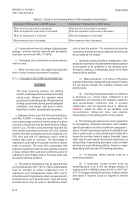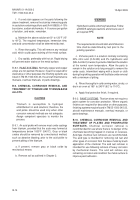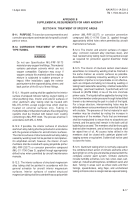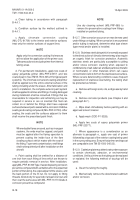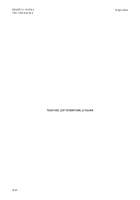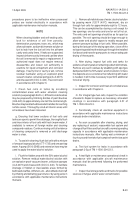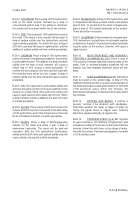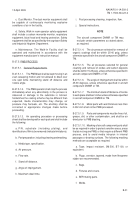TM-1-1500-344-23-2 - Page 224 of 240
B-22
NAVAIR 01-1A-509-2
TM 1-1500-344-23-2
15 April 2009
c. To treat systems by flushing, remove tank or cell
access plates and removable components, as
necessary, to provide maximum access to contaminated
areas. Using a pump (5100-254B) and rubber hose,
pump and circulate the sodium dichromate solution
throughout the tanks and cells, keeping all surfaces wet
for at least 30 minutes. Allow tanks and cells to drain into
receptacles during this operation.
d. As soon as treatment by flushing is completed,
drain all inhibitor solution from system. Immediately
begin rinsing with fresh water and continue rinsing until
rinse water is clear or has only a slight orange tint.
NOTE
Fuel system components contaminated with
salt water that cannot be thoroughly inspected
"in place" for corrosion damage shall be removed
and disassembled sufficiently to establish
internal conditions and for damage correction.
For metering devices and other items, remove
and flush with fresh water, drain, dry, and
preserve internally with water displacing,
corrosion preventive compound (MIL-
PRF-81309 Type II Class 1), tag with the
notation "CONTAMINATED INTERNALLY
WITH SEA WATER", and forward to the
designated maintenance facility for rework.
e. As soon as possible after flushing and inhibiting
treatment, open all cells and tanks by removing access
plates, probes, pumps, fittings, etc., for maximum visual
inspection of interior areas.
f. Remove residual fuel and sodium dichromate
solution using an explosion-proof vacuum cleaner or
cellulose sponges (A-A-2073) and cheesecloth
(CCC-C-440). For cells which are impossible to enter,
use an explosion-proof vacuum cleaner or attach the
cellulose sponge or cheesecloth to a wooden handle for
reaching remote areas.
g. Inspect fuel cells for corrosion and evidence of
microbiological growth. Treat corrosion in accordance
with Chapter 6. If microbiological growth is found proceed
to and comply with paragraph 2-4c of TM 1-1500-204-
23-3.
h. Test fuel system for leaks as outlined in paragraph
2-5g of TM 1-1500-204-23-3.
B-20. MICROBIOLOGICAL GROWTH CONTAMINA-
TION OF FUEL CELLS.
WARNING
Solutions containing isopropyl alcohol
(TT-I-735) are flammable and shall be drained
into safety containers and disposed of in
accordance with local safety instructions.
CAUTION
To prevent possible damage to fuel system
nonmetallic components, the solution
temperature shall not exceed 120
°
F (49
°
C).
a. Defuel aircraft in accordance with instructions
contained in the applicable maintenance manual.
b. Remove capacitance type fuel quantity indicator
probes, internal plumbing, valves, electrical wiring, float
switches, etc., as necessary to gain access to all areas
where salt water or microbiological growth may have
collected, or where hidden corrosive attack may have
occurred. Except for fuel quantity indicator probes (which
shall always be removed and cleaned), the extent of
further component removal shall be determined by the
evidenced need for a more in-depth inspection of a
component.
c. Make up a water emulsion cleaning solution by
adding one part by volume of MIL-PRF-85704 Type I
cleaning compound to nine parts of fresh water.
d. For electrical wiring, fuel quantity indicator probes,
fittings, plumbing lines, and any intricate components
that cannot be effectively cleaned with the water emulsion
cleaning solution and scrubbing with a hog bristle brush
(H-B-420), immerse in water emulsion cleaning solution
for approximately one to three hours. If possible, the
solution should be heated and maintained at
approximately 120
°
F (49
°
C).
e. When all residues have been loosened, rinse
thoroughly with water until items are clean. Drain as well
as possible, rotating items to get complete draining.
Place items in drying ovens maintained at 120
°
F (49
°
C)
maximum for 12 hours. If ovens are not available dry by
immersing items in undiluted isopropyl alcohol (TT-I-735)
for approximately one minute and blow dry with clean
compressed air at a pressure of no more than 10 psi.
Install new fuel quantity probes if these cleaning
Back to Top

